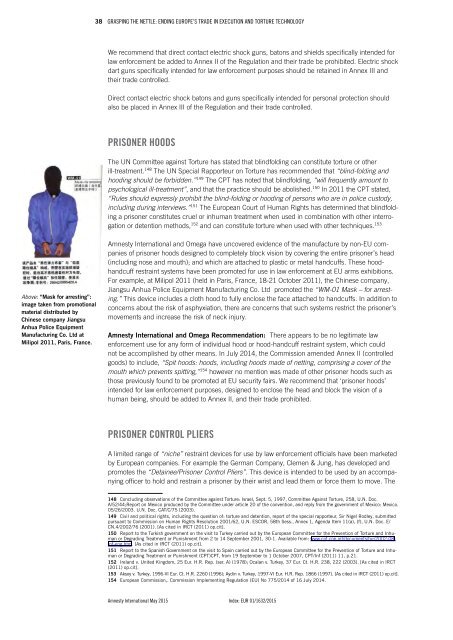Grasping the nettle
1Gsbbd6
1Gsbbd6
Create successful ePaper yourself
Turn your PDF publications into a flip-book with our unique Google optimized e-Paper software.
38 <strong>Grasping</strong> <strong>the</strong> <strong>nettle</strong>: Ending Europe’s Trade in Execution and Torture Technology<br />
We recommend that direct contact electric shock guns, batons and shields specifically intended for<br />
law enforcement be added to Annex II of <strong>the</strong> Regulation and <strong>the</strong>ir trade be prohibited. Electric shock<br />
dart guns specifically intended for law enforcement purposes should be retained in Annex III and<br />
<strong>the</strong>ir trade controlled.<br />
Direct contact electric shock batons and guns specifically intended for personal protection should<br />
also be placed in Annex III of <strong>the</strong> Regulation and <strong>the</strong>ir trade controlled.<br />
Prisoner hoods<br />
The UN Committee against Torture has stated that blindfolding can constitute torture or o<strong>the</strong>r<br />
ill-treatment. 148 The UN Special Rapporteur on Torture has recommended that “blind-folding and<br />
hooding should be forbidden.” 149 The CPT has noted that blindfolding, “will frequently amount to<br />
psychological ill-treatment”, and that <strong>the</strong> practice should be abolished. 150 In 2011 <strong>the</strong> CPT stated,<br />
“Rules should expressly prohibit <strong>the</strong> blind-folding or hooding of persons who are in police custody,<br />
including during interviews.” 151 The European Court of Human Rights has determined that blindfolding<br />
a prisoner constitutes cruel or inhuman treatment when used in combination with o<strong>the</strong>r interrogation<br />
or detention methods, 152 and can constitute torture when used with o<strong>the</strong>r techniques. 153<br />
Above: “Mask for arresting”:<br />
image taken from promotional<br />
material distributed by<br />
Chinese company Jiangsu<br />
Anhua Police Equipment<br />
Manufacturing Co. Ltd at<br />
Milipol 2011, Paris, France.<br />
Amnesty International and Omega have uncovered evidence of <strong>the</strong> manufacture by non-EU companies<br />
of prisoner hoods designed to completely block vision by covering <strong>the</strong> entire prisoner’s head<br />
(including nose and mouth); and which are attached to plastic or metal handcuffs. These hoodhandcuff<br />
restraint systems have been promoted for use in law enforcement at EU arms exhibitions.<br />
For example, at Milipol 2011 (held in Paris, France, 18-21 October 2011), <strong>the</strong> Chinese company,<br />
Jiangsu Anhua Police Equipment Manufacturing Co. Ltd promoted <strong>the</strong> “WM-01 Mask – for arresting.”<br />
This device includes a cloth hood to fully enclose <strong>the</strong> face attached to handcuffs. In addition to<br />
concerns about <strong>the</strong> risk of asphyxiation, <strong>the</strong>re are concerns that such systems restrict <strong>the</strong> prisoner’s<br />
movements and increase <strong>the</strong> risk of neck injury.<br />
Amnesty International and Omega Recommendation: There appears to be no legitimate law<br />
enforcement use for any form of individual hood or hood-handcuff restraint system, which could<br />
not be accomplished by o<strong>the</strong>r means. In July 2014, <strong>the</strong> Commission amended Annex II (controlled<br />
goods) to include, “Spit hoods: hoods, including hoods made of netting, comprising a cover of <strong>the</strong><br />
mouth which prevents spitting,” 154 however no mention was made of o<strong>the</strong>r prisoner hoods such as<br />
those previously found to be promoted at EU security fairs. We recommend that ‘prisoner hoods’<br />
intended for law enforcement purposes, designed to enclose <strong>the</strong> head and block <strong>the</strong> vision of a<br />
human being, should be added to Annex II, and <strong>the</strong>ir trade prohibited.<br />
Prisoner control pliers<br />
A limited range of “niche” restraint devices for use by law enforcement officials have been marketed<br />
by European companies. For example <strong>the</strong> German Company, Clemen & Jung, has developed and<br />
promotes <strong>the</strong> “Detainee/Prisoner Control Pliers”. This device is intended to be used by an accompanying<br />
officer to hold and restrain a prisoner by <strong>the</strong>ir wrist and lead <strong>the</strong>m or force <strong>the</strong>m to move. The<br />
148 Concluding observations of <strong>the</strong> Committee against Torture: Israel, Sept. 5, 1997, Committee Against Torture, 258, U.N. Doc.<br />
A/52/44;Report on Mexico produced by <strong>the</strong> Committee under article 20 of <strong>the</strong> convention, and reply from <strong>the</strong> government of Mexico: Mexico.<br />
05/26/2003. U.N. Doc. CAT/C/75 (2003).<br />
149 Civil and political rights, including <strong>the</strong> question of: torture and detention, report of <strong>the</strong> special rapporteur, Sir Nigel Rodley, submitted<br />
pursuant to Commission on Human Rights Resolution 2001/62, U.N. ESCOR, 58th Sess., Annex 1, Agenda Item 11(a), (f), U.N. Doc. E/<br />
CN.4/2002/76 (2001). [As cited in IRCT (2011) op.cit].<br />
150 Report to <strong>the</strong> Turkish government on <strong>the</strong> visit to Turkey carried out by <strong>the</strong> European Committee for <strong>the</strong> Prevention of Torture and Inhuman<br />
or Degrading Treatment or Punishment from 2 to 14 September 2001, 30-1. Available from: www.cpt.coe.int/documents/tur/2002-08-<br />
inf-eng.htm. [As cited in IRCT (2011) op.cit].<br />
151 Report to <strong>the</strong> Spanish Government on <strong>the</strong> visit to Spain carried out by <strong>the</strong> European Committee for <strong>the</strong> Prevention of Torture and Inhuman<br />
or Degrading Treatment or Punishment (CPT)CPT, from 19 September to 1 October 2007, CPT/Inf (2011) 11, p.21.<br />
152 Ireland v. United Kingdom, 25 Eur. H.R. Rep. (ser. A) (1978); Ocalan v. Turkey, 37 Eur. Ct. H.R. 238, 222 (2003). [As cited in IRCT<br />
(2011) op.cit].<br />
153 Aksoy v. Turkey, 1996-VI Eur. Ct. H.R. 2260 (1996); Aydin v. Turkey, 1997-VI Eur. H.R. Rep. 1866 (1997). [As cited in IRCT (2011) op.cit].<br />
154 European Commission,. Commission Implementing Regulation (EU) No 775/2014 of 16 July 2014.<br />
Amnesty International May 2015 Index: EUR 01/1632/2015


